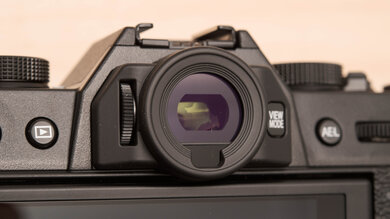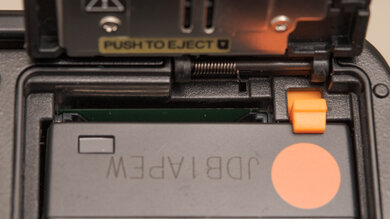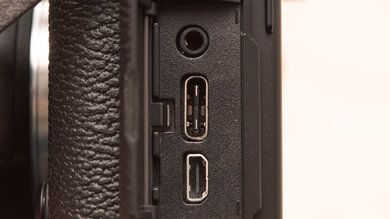The Fujifilm X-T30 is a mirrorless DSLR camera with an interchangeable lens. It has a good image quality with a great autofocus performance, so you can take pictures that are sharp and relatively free of visible noise even at high ISO levels. It also supports 4k and FHD video recording, and while its 4k video quality is good, there's a bit more visible noise when you record in FHD. While this camera is portable and lightweight, users with larger hands may find it a bit uncomfortable to hold while shooting.
Our Verdict
The Fujifilm X-T30 is good for travel photography. It has good image quality, so your images are clear and detailed. Its impressive autofocus system can help keep moving objects in focus, too. Its low minimum shutter speed also helps you take long exposure photographs. It's very portable, but people with larger hands may find it difficult to get a comfortable grip.
-
Portable, lightweight design.
-
Good image quality.
-
Not really comfortable for larger hands.
The Fujifilm X-T30 is good for landscape photography. It has a good image quality, so your images are sharp and without a lot of visible noise. There's also manual focus assistance to help you get a clear shot, and it has a well-built, portable design. While its lens lets in a lot of light, it has some noticeable light falloff that can make the corners of your shot look darker than the middle.
-
Portable, lightweight design.
-
Good image quality.
-
Not really comfortable for larger hands.
The Fujifilm X-T30 is satisfactory for sports and wildlife photography. Its shooting speed is just okay, so you may have some difficulty getting clear images of fast-moving subjects. That said, this camera has a good image quality, so your pictures don't have a lot of visible noise. Also, its autofocus system is impressive, which helps keep the focus on moving subjects.
-
Good image quality.
-
Mediocre continuous high shooting speed.
The Fujifilm X-T30 is decent for vlogging. It has decent FHD video quality, and it produces an even sharper image when recording in 4k. It's portable, and it does an amazing job smoothing out camera shake if you're running or walking while filming. However, its screen isn't fully articulated, and you can't flip it around to see yourself while you film.
-
Amazing image stabilization performance in 4k and FHD.
-
Good 4k video quality.
-
Portable, lightweight design.
-
Screen tilts but doesn't rotate.
-
Not really comfortable for larger hands.
The Fujifilm X-T30 is good for studio video. Its video quality in FHD is decent, and there's even less visible noise present when you record in 4k. It also has a lot of inputs and outputs for videography accessories like a microphone and an external recorder. However, with recording time limits of 10 minutes in 4k and 15 minutes in FHD, it's not really ideal for long recording sessions.
-
Lots of inputs and outputs.
-
Outstanding video autofocus performance.
-
Good 4k video quality.
-
No headphones input.
-
Recording time limits may be prohibitive.
The Fujifilm X-T30 is poor for action video. It isn't really designed for this use, as it can't be mounted on a helmet and isn't dust or water-resistant. It has a high-speed recording mode in FHD that captures footage at 120 fps, but it can only shoot 4k up to 30 fps. That said, its video stabilization performance in 4k and FHD is amazing, so your video is free of camera shake even if you're running while filming.
-
Amazing image stabilization performance in 4k and FHD.
-
No advertised dust and water resistance.
-
Limited 4k frame rate options.
- 7.6 Travel Photography
- 7.9 Landscape Photography
- 7.1 Sport & Wildlife Photography
- 6.5 Vlogging
- 7.2 Studio Video
- 4.9 Action Video
Changelog
- Updated Aug 14, 2023: We've updated the sensor type to 'BSI CMOS' to reflect the sensor's back-illuminated design. We previously only noted that it was a 'CMOS' sensor.
- Updated Jun 06, 2023: We've updated the 'App Name' in the 'Menu System' section of the review to reflect this camera's compatibility with Fujifilm's new XApp.
- Updated Apr 05, 2023: Converted to Test Bench 0.12.
- Updated Mar 21, 2023: Converted to Test Bench 0.11.
- Updated Sep 23, 2022: Converted to Test Bench 0.10.
Check Price
Differences Between Sizes And Variants
The Fujifilm X-T30 comes in several different color variants: 'Black', 'Silver', and 'Charcoal Silver'. We tested the 'Black' variant with the FUJINON XF 18-55mm F/2.8-4 R lens, and you can see its label here. We expect the other color variants to perform similarly.
You can also purchase this camera in each color scheme with the FUJINON XC 15-45mm F/3.5-5.6 OIS PZ lens or without a lens at all, but we haven't tested the performance of these variants.
If you come across another version, let us know in the discussions so we can update our review.
Compared To Other Cameras
The Fujifilm X-T5 sits above the Fujifilm X-T30 in Fujifilm's lineup and has a few advantages. It uses a newer, higher-resolution sensor, a higher-resolution EVF, and an improved autofocus system. It also has better video features, including more frame rate options and better internal recording capabilities. That said, the X-T30 is more portable and still has an excellent sensor, so it may be a good option if you prefer something more compact for photography.
The Fujifilm X-T30 II is a refreshed version of the Fujifilm X-T30. The cameras look almost identical on the outside, though the Mark II has a higher-resolution tilting screen. The X-T30 II also has internal upgrades, including a newer autofocus system, a slightly larger photo buffer, and longer video recording time limits. Overall, it's a solid improvement, but if you already own an X-T30, it isn't different enough to warrant an upgrade.
Test Results
If you want longer recording times, check out the Fujifilm X-T30 II, which can record 4k video for up to 30 minutes.
Update 12/21/2021: Like other Fujifilm cameras we've tested, the X-T30 has a high-speed recording mode that can capture 1080p footage at 120 fps for slow-motion playback, though using this feature incurs a slight crop.
Comments
Fujifilm X-T30: Main Discussion
Let us know why you want us to review the product here, or encourage others to vote for this product.
Update: We’ve updated the sensor type to ‘BSI CMOS’ to reflect the sensor’s back-illuminated design. We previously only noted that it was a ‘CMOS’ sensor.































































